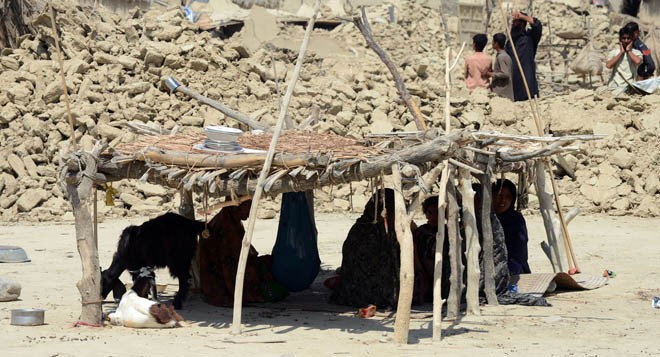

More than eight months have passed since the deadly Awaran quake in Balochistan that took more than 800 lives in September 2013. Initial estimates informed that about 46000 houses were partly or completely destroyed in an area of 15400 square miles.
Apart from natural calamities, the province is deeply impacted by the ongoing insurgency, terrorist attacks on civilian population and sectarian strife. Under these circumstances, it becomes a challenging task to initiate any worthwhile and sustainable project of rehabilitation and redevelopment. Awaran and Kech-Turbat are two under-developed districts in Balochistan which were most severely hit.
The urgency of the situation motivated the Urban Resource Centre (URC) and Technical Training and Resource Centre (TTRC) in Karachi to launch a low-cost and community-led process to rehabilitate housing and infrastructure and extend technical support to needy population. URC is an NGO founded by a group of professionals for facilitating development, advocacy and knowledge resources through involvement of local stakeholders. TTRC is a group of para-professionals who received vocational training from the Orangi Pilot Project and now undertake development work with low-cost and humble approaches.
Experiences have proved that community driven process for development and rehabilitation are the most effective options, both in usual circumstances of squalor and poverty as well as post-disaster reconstruction. The URC/TTRC team adopted this simple but time-tested approach after undertaking a reconnaissance of the area and meeting with various categories of people. Four village sites were chosen -- Khan Mohammad Bazaar, Niabat, Daroga Burfi Bazaar and Nadgo Pirandar -- for the project. These locations comprised households impacted by extreme poverty. People were dependent on subsistence agriculture and livestock rearing.
As the houses were dispersed along the arid landscape, the physical density of the settlements was very low. Drinking water was acquired through wells and hand pumps. Due to perennial dry spells, the wells would dry up seasonally, thus increasing difficulties for people. After the earthquake, many water sources were damaged and needed urgent repairs through appropriate technical means.
The adopted process comprised selection of the most deserving households for technical support and provision of construction material. The villagers were invited to formulate a committee of elders to identify such households. Each committee had an elected convener to coordinate the various tasks. It is most promising to note that every village elected a noted schoolteacher to deal with routine affairs. This showed that the most ordinary people of Balochistan not only valued education but also respected those who imparted it. It was found that a total of 1141 houses were damaged but support could be initially extended to 125 houses.
The support comprised developing simple designs for damaged walls and roofing structures. Steel beams, bamboos, plastic mats, reef mats and ropes were the total outlay of the inventory. It may be remembered that URC/TTRC team on the site included architects and technicians, though of a different kind. These professionals have given up commercial practice and devoted their careers to work for under-privileged communities. They helped train the local community members in simple tips in fabrication and construction. And in a record period of three months, 125 houses were completely reconstructed.
The team also helped repair and rehabilitate 18 water supply schemes in the targeted communities. The whole venture, which was financially supported by Asian Coalition for Community Action (ACCA) -- a regional body of development organisation -- cost Rs1.6 million approximately. The cost of technical assistance was around Rs70,000.
There are many important lessons that this simple initiative has to offer. One, with small financial resources and appropriate technical guidance, large scale development can be achieved. This lesson was also advocated by Dr Akhtar Hameed Khan and Architect Perween Rahman who demonstrated the success of this model in many parts of Pakistan and abroad. This is a flexible approach where the most pressing developmental need is targeted and transformed into a community mobilisation initiative.
Two, the people are the best practitioners of sustainable development. They only need help in technical issues and identification of development choices. This type of help can best be provided by socially responsive professionals who are rooted in the society. Neither fancy donor-funded projects nor expensive foreign consultants can qualify for this intended change.
Three, when the community manages and monitors the development process, it gains collective confidence and ability to manage ventures for collective improvement. This experience may be studied by the relevant departments of the government for the purpose of replication in various parts of Balochistan. It is also a useful learning for policy makers to utilise the energies of mobilised communities for extending development projects. If low-cost and simple approaches are adopted, the fruits of development shall reach many under-developed and impoverished areas of Balochistan and elsewhere without any burden on the exchequer.
The total cost of repairing 125 houses and 18 water supply schemes was less than the cost of one staff car purchased for a mid-ranking bureaucrat! It adequately proves that sustainable development is not resource-intensive.